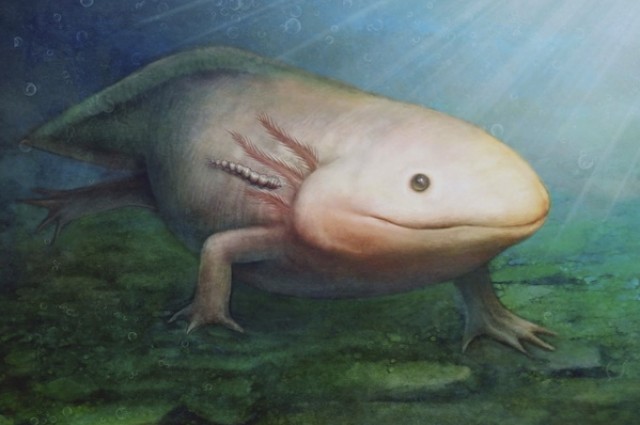We reach more than 65,000 registered users in Dec!! Register Now

Bizarre bloodsucking parasite from Jurassic found
- June 26, 2014
- 781 Views
- 0 Likes
- 0 Comment
Re≠search≠ers from the Uni≠vers≠ity of Bonn and from Chi≠na have dis≠cov≠ered a fos≠sil fly lar≠va with such a spec≠tac≠u≠lar suck≠ing ap≠pa≠rat≠us, they have named it by the Chin≠ese word for "bizarre." Around 165 mil≠lion years ago, a spec≠tac≠u≠lar par≠a≠site was at home in the fresh≠wa≠ter lakes of pre≠s≠ent-day In≠ner Mon≠go≠lia in ...
Re≠search¬≠ers from the Uni¬≠vers¬≠ity of Bonn and from Chi¬≠na have dis¬≠cov¬≠ered a fos¬≠sil fly lar¬≠va with such a spec¬≠tac¬≠u¬≠lar suck¬≠ing ap¬≠pa¬≠rat¬≠us, they have named it by the Chin¬≠ese word for ‚Äúbizarre.‚ÄĚ
Around 165 mil¬≠lion years ago, a spec¬≠tac¬≠u¬≠lar par¬≠a¬≠site was at home in the fresh¬≠wa¬≠ter lakes of pre¬≠s¬≠ent-day In¬≠ner Mon¬≠go¬≠lia in Chi¬≠na, re¬≠search¬≠ers say. It was a ju¬≠ve¬≠nile fly with a thor¬≠ax, or ‚Äúch¬≠est,‚ÄĚ formed en¬≠tirely like a suck¬≠ing plate.
With it, the an­i­mal could stick to sala­man­ders and suck their blood with its mouth­parts formed like a sting, ac­cord­ing to sci­en­tists. To date no in­sect is known with a si­m­i­lar de­sign. The in­terna­t­ional sci­en­tif­ic team is now pre­sent­ing its find­ings in the jour­nal eLIFE.
The par­a­site, a long fly lar­va around two cen­time­ters (a bit un­der an inch) long, had un­der­gone ex­treme changes over the course of ev­o­lu­tion, the re­search­ers said. The head is ti­ny in com­par­i­son to the body, tube-shaped with piercer-like mouth­parts at the front. The mid-body, or thor­ax, has been com­pletely trans­formed un­derneath in­to a gi­gantic suck­ing plate; the hind-body, or ab­do­men, has caterpillar-like legs.
The re­search team be­lieves that this un­usu­al an­i­mal lived in a land­scape with vol­ca­noes and lakes what is now north­east­ern Chi­na around 165 mil­lion years ago. In this fresh wa­ter hab­i­tat, they say, the par­a­site crawled on­to pass­ing sala­man­ders, at­tached it­self with its suck­ing plate, and pen­e­trated the thin skin of the am­phib­ians in or­der to suck blood from them.
‚ÄúThe par¬≠a¬≠site lived the life of Reil¬≠ly,‚ÄĚ said paleon¬≠tologist Jes Rust from the Uni¬≠vers¬≠ity of Bonn. This is be¬≠cause there were many sala¬≠man¬≠ders in the lakes, as fos¬≠sil finds at the same loca¬≠t¬≠ion near Ningcheng in In¬≠ner Mon¬≠go¬≠lia (Chi¬≠na) have shown. ‚ÄúThere sci¬≠en¬≠tists had al¬≠so found around 300,000 di¬≠verse and ex¬≠cep¬≠tion¬≠ally pre¬≠served fos¬≠sil in¬≠sects,‚ÄĚ said the Chin¬≠ese sci¬≠ent¬≠ist Bo Wang, a post¬≠doc¬≠tor¬≠al re¬≠searcher in paleon¬≠tology at the Uni¬≠vers¬≠ity of Bonn.
The lar¬≠va, which has re¬≠ceived the sci¬≠en¬≠tif¬≠ic name of¬†Qiyia juras¬≠si¬≠ca, how¬≠ev¬≠er, was a quite un¬≠ex¬≠pected find. ‚ÄúQiyia‚ÄĚ in Chin¬≠ese means ‚Äúbizarre‚ÄĚ; ‚Äújur¬≠as¬≠si¬≠ca‚ÄĚ refers to the Ju¬≠ras¬≠sic pe¬≠ri¬≠od to which the fos¬≠sils be¬≠long. A fine-grained mud¬≠stone en¬≠sured the good state of pre¬≠serva¬≠t¬≠ion of the fos¬≠sil.
![Europasaurus_holgeri_Scene_2[1]](http://machprinciple.com/wp-content/uploads/2014/06/Europasaurus_holgeri_Scene_21-1024x768.jpg)
Source : http://www.world-science.net









